Spatiotemporal Patterns of Pasture Quality Based on NDVI Time-Series in Mediterranean Montado Ecosystem
Abstract
:1. Introduction
2. Materials and Methods
2.1. Study Area
2.2. Data
2.2.1. Satellite Remote Sensing Data
2.2.2. Proximal Sensing Data
2.2.3. Pasture Samples
2.3. Statistical Analysis
3. Results
4. Discussion
4.1. Evolution of Pasture Quality Parameter Patterns throughout the Vegetative Cycle
4.2. Correlation between Pasture Quality Parameters and NDVI Obtained from Proximal and Remote Sensing
5. Conclusions
Author Contributions
Funding
Institutional Review Board Statement
Informed Consent Statement
Data Availability Statement
Acknowledgments
Conflicts of Interest
References
- Reinermann, S.; Asam, S.; Kuenzer, C. Remote sensing of grassland production and management—A review. Remote Sens. 2020, 12, 1949. [Google Scholar] [CrossRef]
- Ali, I.; Cawkwell, F.; Dwyer, E.; Barret, B.; Green, S. Satellite remote sensing of grasslands: From observation to management—A review. J. Plant Ecol. 2016, 9, 649–671. [Google Scholar] [CrossRef] [Green Version]
- Hardy, T.; Kooistra, L.; Franceschini, M.D.; Richter, S.; Vonk, E.; Eertwegh, G.; Deijl, D. Sen2Grass: A cloud-based solution to generate field-specific grassland information derived from Sentinel-2 imagery. AgriEngineering 2021, 3, 118–137. [Google Scholar] [CrossRef]
- Fernández-Habas, J.; Moreno, A.M.G.; Hidalgo-Fernández, M.A.T.; Leal-Murillo, J.R.; Oar, B.A.; Gámez-Giráldez, P.J.; González-Dugo, M.P.; Fernández-Rebollo, P. Investigating the potential of Sentinel-2 configuration to predict the quality of Mediterranean permanent grasslands in open woodlands. Sci. Total Environ. 2021, 791, 148101. [Google Scholar] [CrossRef] [PubMed]
- Stumpf, F.; Schneider, M.K.; Keller, A.; Mayr, A.; Rentschler, T.; Meuli, R.G.; Schaepman, M.; Liebisch, F. Spatial monitoring of grassland management using multi-temporal satellite imagery. Ecol. Indic. 2020, 113, 106201. [Google Scholar] [CrossRef]
- Efe Serrano, J. Pastures in Alentejo: Technical Basis for Characterization, Grazing and Improvement; Universidade de Évora—ICAM: Évora, Portugal, 2006; pp. 165–178. [Google Scholar]
- Serrano, J.; Shahidian, S.; Costa, F.; Carreira, E.; Pereira, A.; Carvalho, M. Can soil pH correction reduce the animal supplementation needs in the critical autumn period in Mediterranean Montado ecosystem? Agronomy 2021, 11, 514. [Google Scholar] [CrossRef]
- Lugassi, R.; Chudnovsky, A.; Zaady, E.; Dvash, L.; Goldshleger, N. Spectral slope as an indicator of pasture quality. Remote Sens. 2015, 7, 256–274. [Google Scholar] [CrossRef] [Green Version]
- Wijesingha, J.; Astor, T.; Schulze-Brüninghoff, D.; Wengert, M.; Wachendorf, M. Predicting forage quality of grasslands using UAV-borne imaging spectroscopy. Remote Sens. 2020, 12, 126. [Google Scholar] [CrossRef] [Green Version]
- Barnetson, J.; Phinn, S.; Scarth, P. Estimating plant pasture biomass and quality from UAV imaging across Queensland’s Rangelands. AgriEngineering 2020, 2, 523–543. [Google Scholar] [CrossRef]
- Serrano, J.; Shahidian, S.; Marques da Silva, J. Evaluation of normalized difference water index as a tool for monitoring pasture seasonal and inter-annual variability in a Mediterranean agro-silvo-pastoral system. Water 2019, 11, 62. [Google Scholar] [CrossRef] [Green Version]
- Nickmilder, C.; Tedde, A.; Dufrasne, I.; Lessire, F.; Tychon, B.; Curnel, Y.; Bindelle, J.; Soyeurt, H. Development of machine learning models to predict compressed sward height in Walloon pastures based on Sentinel-1, Sentinel-2 and meteorological data using multiple data transformations. Remote Sens. 2021, 13, 408. [Google Scholar] [CrossRef]
- Dos Reis, A.A.; Werner, J.P.S.; Silva, B.C.; Figueiredo, G.K.D.A.; Antunes, J.F.G.; Esquerdo, J.C.D.M.; Coutinho, A.C.; Lamparelli, R.A.C.; Rocha, J.V.; Magalhães, P.S.G. Monitoring pasture aboveground biomass and canopy height in an integrated crop–livestock system using textural information from PlanetScope imagery. Remote Sens. 2020, 12, 2534. [Google Scholar] [CrossRef]
- Chen, Y.; Guerschman, J.; Shendryk, Y.; Henry, D.; Harrison, M.T. Estimating pasture biomass using Sentinel-2 imagery and machine learning. Remote Sens. 2021, 13, 603. [Google Scholar] [CrossRef]
- Clementini, C.; Pomente, A.; Latini, D.; Kanamaru, H.; Vuolo, M.R.; Heureux, A.; Fujisawa, M.; Schiavon, G.; Del Frate, F. Long-term grass biomass estimation of pastures from satellite data. Remote Sens. 2020, 12, 2160. [Google Scholar] [CrossRef]
- Serrano, J.; Shahidian, S.; da Silva, J.M. Monitoring seasonal pasture quality degradation in the Mediterranean montado ecosystem: Proximal versus remote sensing. Water 2018, 10, 1422. [Google Scholar] [CrossRef] [Green Version]
- AOAC. AOAC Official Methods of Analysis of AOAC International, 18th ed.; AOAC International: Arlington, VA, USA, 2005. [Google Scholar]
- Goering, H.K.; Van Soest, P.J. Forage Fibre Analysis (Apparatus Reagents, Procedures and Some Applications); Agriculture Handbook no. 379; USDA-ARS: Albany, NY, USA, 1970. [Google Scholar]
- Lugassi, R.; Zaady, E.; Goldshleger, N.; Shoshany, M.; Chudnovsky, A. Spatial and temporal monitoring of pasture ecological quality: Sentinel-2-based estimation of crude protein and neutral detergent fiber contents. Remote Sens. 2019, 11, 799. [Google Scholar] [CrossRef] [Green Version]
- Serrano, J.; Peça, J.; Marques da Silva, J.; Shahidian, S. Spatial and temporal stability of soil phosphate concentration and pasture dry matter yield. Precis. Agric. 2011, 12, 214–232. [Google Scholar] [CrossRef]
- Serrano, J.; Shahidian, S.; Marques da Silva, J.; Carvalho, M. A holistic approach to the evaluation of the montado ecosystem using proximal sensors. Sensors 2018, 18, 570. [Google Scholar] [CrossRef] [Green Version]
- Duranovich, F.N.; Yule, I.J.; Lopez-Villalobos, N.; Shadbolt, N.M.; Draganova, I.; Morris, S.T. Using proximal hyperspectral sensing to predict herbage nutritive value for dairy farming. Agronomy 2020, 10, 1826. [Google Scholar] [CrossRef]
- Raab, C.; Riesch, F.; Tonn, B.; Barrett, B.; Meißner, M.; Balkenhol, N.; Isselstein, J. Target-oriented habitat and wildlife management: Estimating forage quantity and quality of semi-natural grasslands with Sentinel-1 and Sentinel-2 data. Remote Sens. Ecol. Con. 2020, 6, 381–398. [Google Scholar] [CrossRef]
- Vilar, P.; Morais, T.G.; Rodrigues, N.R.; Gama, I.; Monteiro, M.L.; Domingos, T.; Teixeira, R.F.M. Object-based classification approaches for multitemporal identification and monitoring of pastures in agroforestry regions using multispectral unmanned aerial vehicle products. Remote Sens. 2020, 12, 814. [Google Scholar] [CrossRef] [Green Version]
- Zhao, F.; Xu, B.; Yang, X.; Jin, Y.; Li, J.; Xia, L.; Chen, S.; Ma, H. Remote sensing estimates of grassland aboveground biomass based on MODIS net primary productivity (NPP): A case study in the Xilingol grassland of Northern China. Remote Sens. 2014, 6, 5368–5386. [Google Scholar] [CrossRef] [Green Version]
- Pullanagari, R.R.; Yule, I.J.; Tuoy, M.P.; Hedley, M.J.; Dynes, R.A.; King, W.M. In-field hyperspectral proximal sensing for estimating quality parameters of mixed pasture. Precision Agric. 2012, 13, 351–369. [Google Scholar] [CrossRef]
- Zhao, D.; Starks, P.; Brown, M.; Phillips, W.; Coleman, S. Assessment of forage biomass and quality parameters of bermudagrass using proximal sensing of pasture canopy reflectance. Grassl. Sci. 2007, 53, 39–49. [Google Scholar] [CrossRef]
- Fava, F.; Colombo, R.; Bocchi, S.; Meroni, M.; Sitzia, M.; Fois, N.; Zucca, C. Identification of hyperspectral vegetation indices for Mediterranean pasture characterization. Int. J. Appl. Earth Obs. Geoinf. 2009, 11, 233–243. [Google Scholar] [CrossRef]
- Punalekar, S.M.; Verhoef, A.; Quaife, T.L.; Humphries, D.; Bermingham, L.; Reynolds, C.K. Application of Sentinel-2A data for pasture biomass monitoring using a physically based radiative transfer model. Remote Sens. Environ. 2018, 218, 207–220. [Google Scholar] [CrossRef]
- Wachendorf, M.; Fricke, T.; Möckel, T. Remote sensing as a tool to assess botanical composition, structure, quantity and quality of temperate grasslands. Grass Forage Sci. 2018, 73, 1–14. [Google Scholar] [CrossRef]
- Michez, A.; Philippe, L.; David, K.; Sébastien, C.; Christian, D.; Bindelle, J. Can low-cost unmanned aerial systems describe the forage quality heterogeneity? Insight from a Timothy pasture case study in Southern Belgium. Remote Sens. 2020, 12, 1650. [Google Scholar] [CrossRef]
- Morais, T.G.; Teixeira, R.F.M.; Rodrigues, N.R.; Domingos, T. Characterizing livestock production in Portuguese sown rainfed grasslands: Applying the inverse approach to a process-based model. Sustainability 2018, 10, 4437. [Google Scholar] [CrossRef] [Green Version]
- Pérez-Ramos, I.M.; Cambrolléb, J.; Hidalgo-Galveza, M.D.; Matías, L.; Montero-Ramírez, A.; Santolaya, S.; Godoy, Ó. Phenological responses to climate change in communities of plants species with contrasting functional strategies. Environ. Exp. Bot. 2020, 170, 103852. [Google Scholar] [CrossRef]
- García-Baquero, G.; Odriozola, I.; Aldezabal, A. Floristic composition mediates change in forage nutritive quality of Atlantic mountain grasslands after experimental grazing exclusion. Agronomy 2021, 11, 25. [Google Scholar] [CrossRef]
- Socher, S.A.; Prati, D.; Boch, S.; Müller, J.; Baumbach, H.; Gockel, S.; Hemp, A.; Schöning, I.; Wells, K.; Buscot, F.; et al. Interacting effects of fertilization, mowing and grazing on plant species diversity of 1500 grasslands in Germany differ between regions. Basic Appl. Ecol. 2013, 14, 126–136. [Google Scholar] [CrossRef]
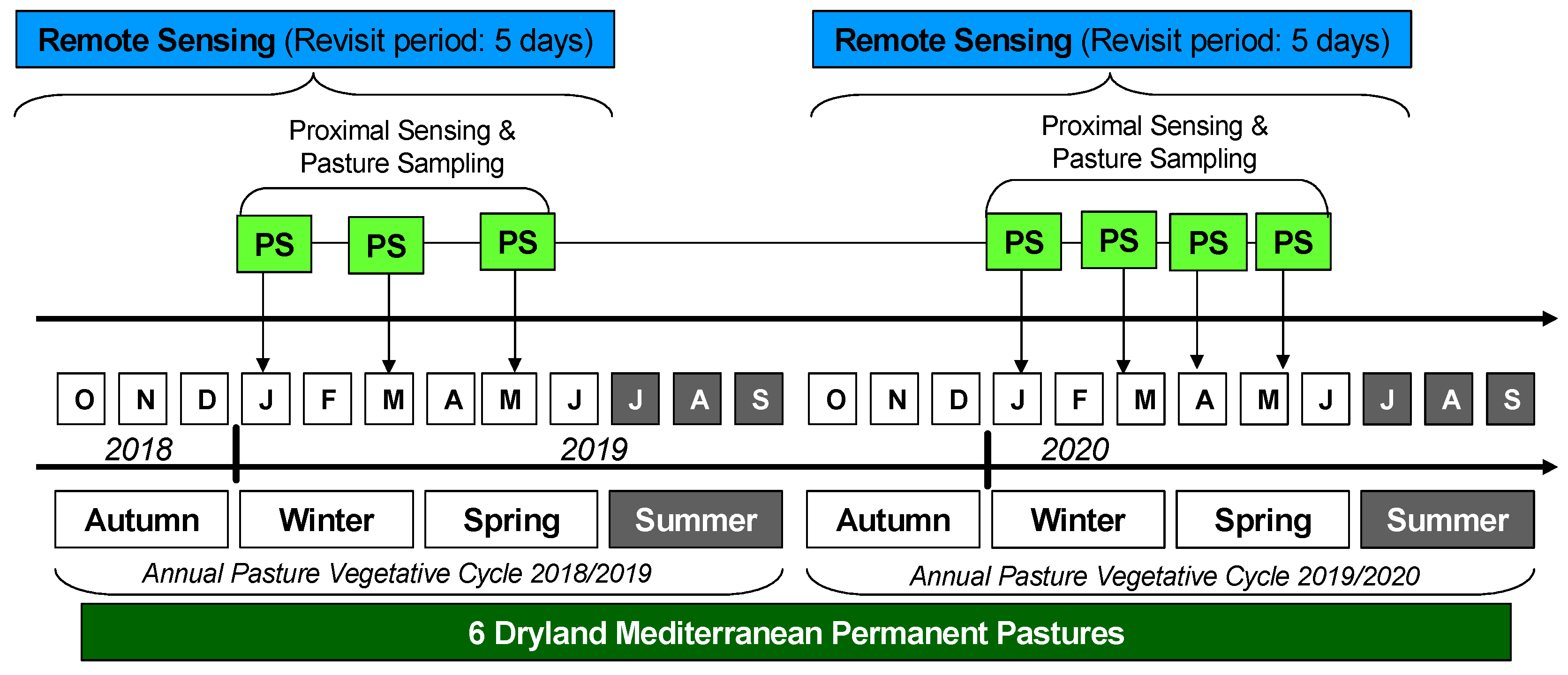
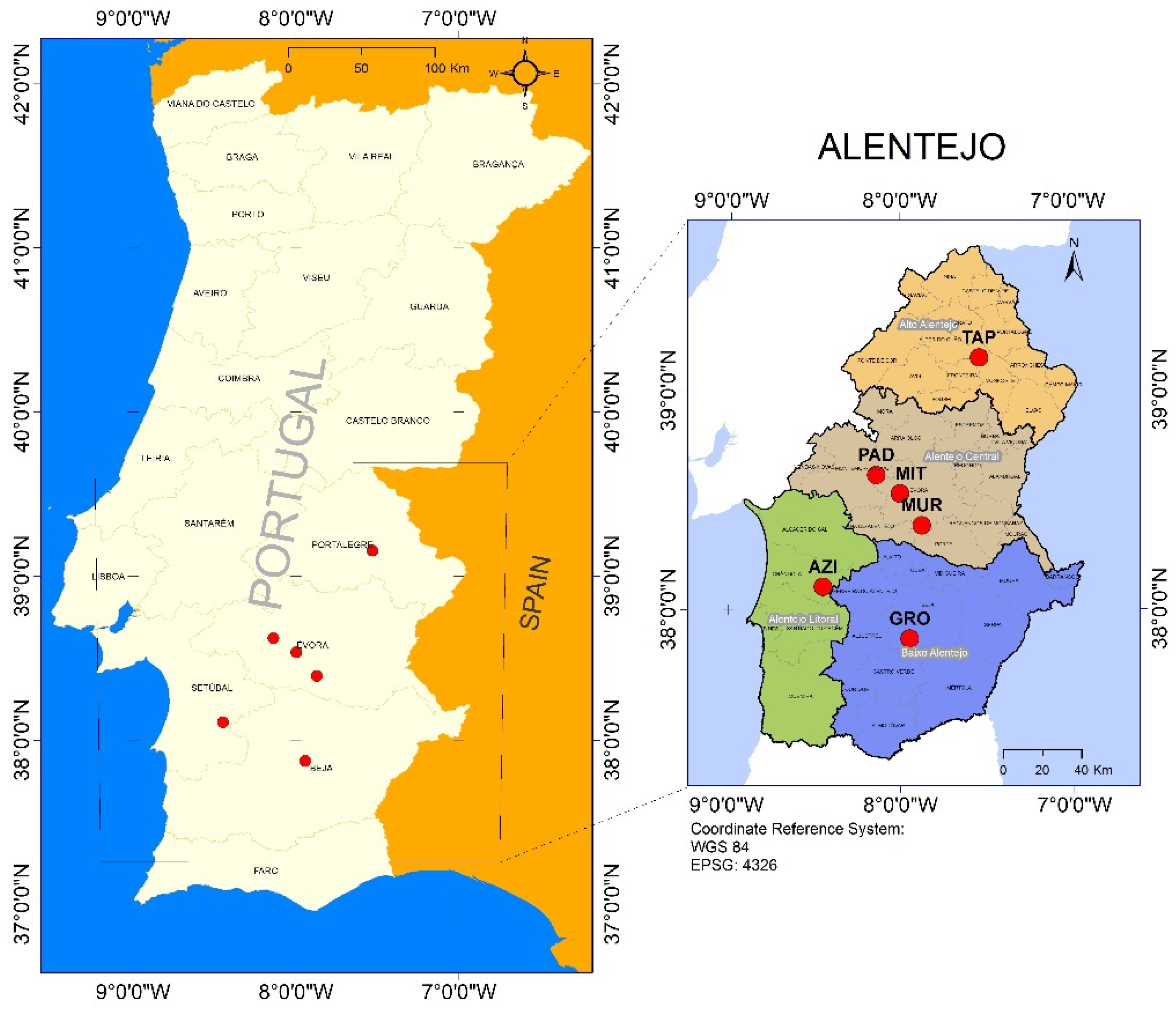
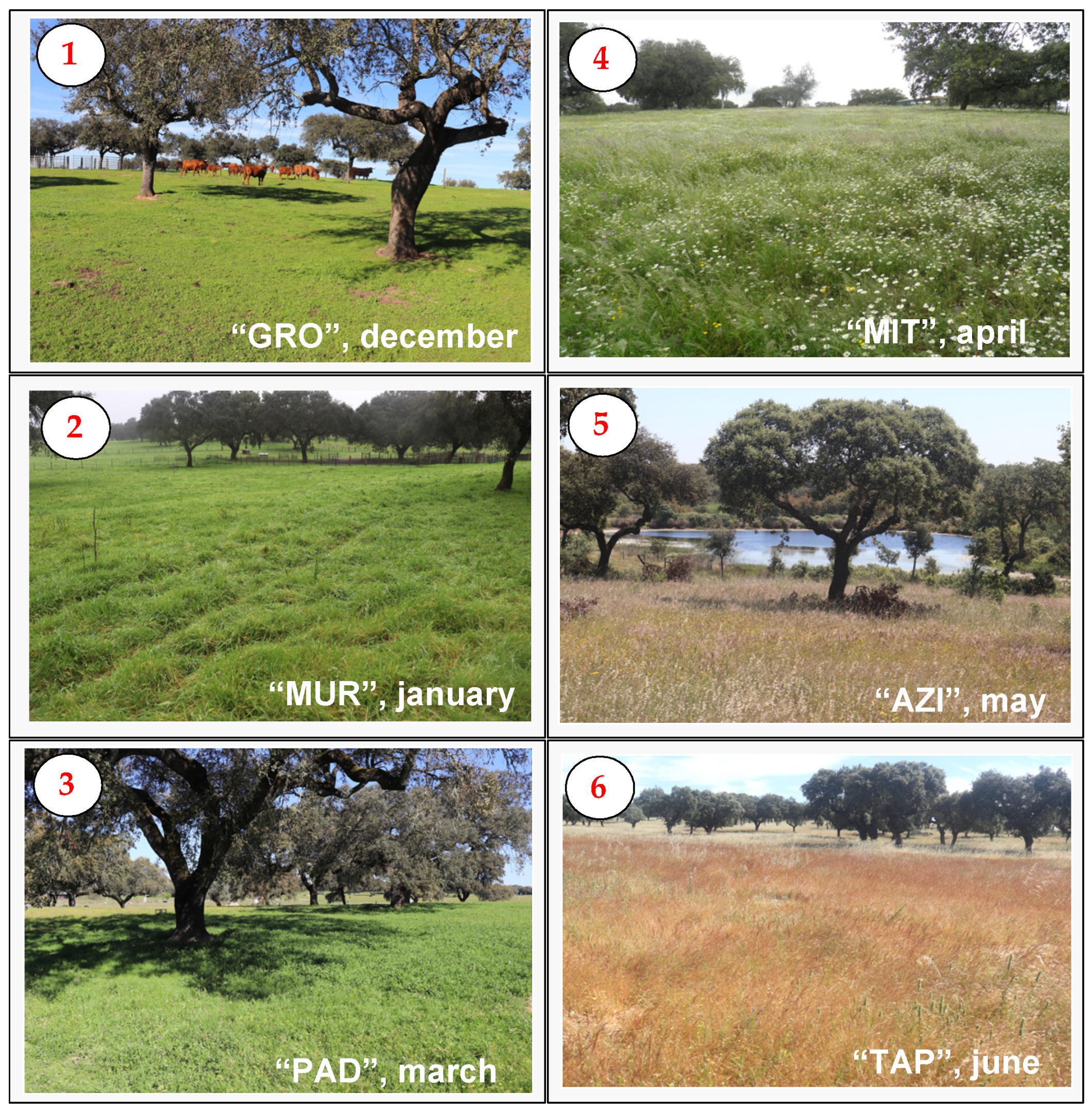
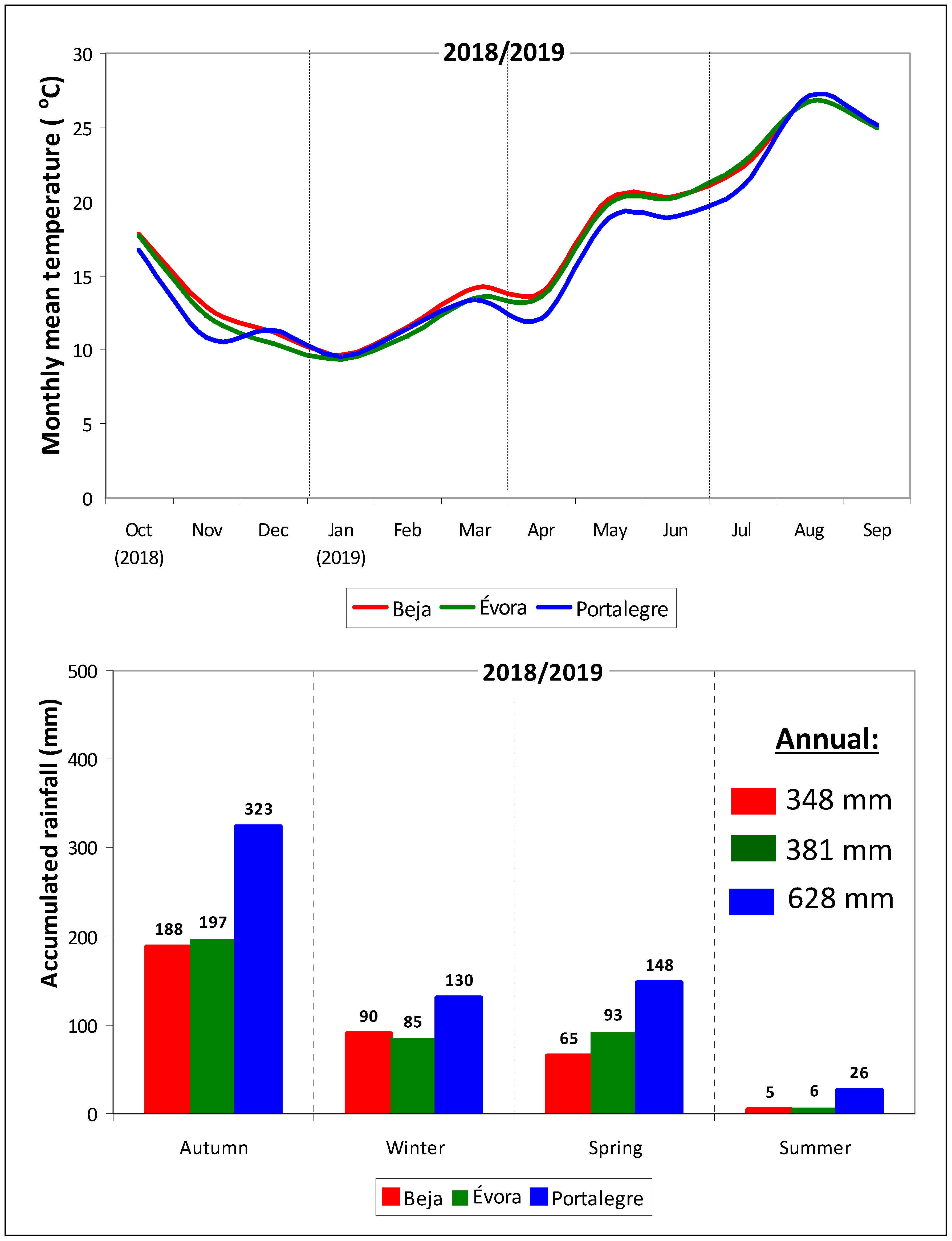
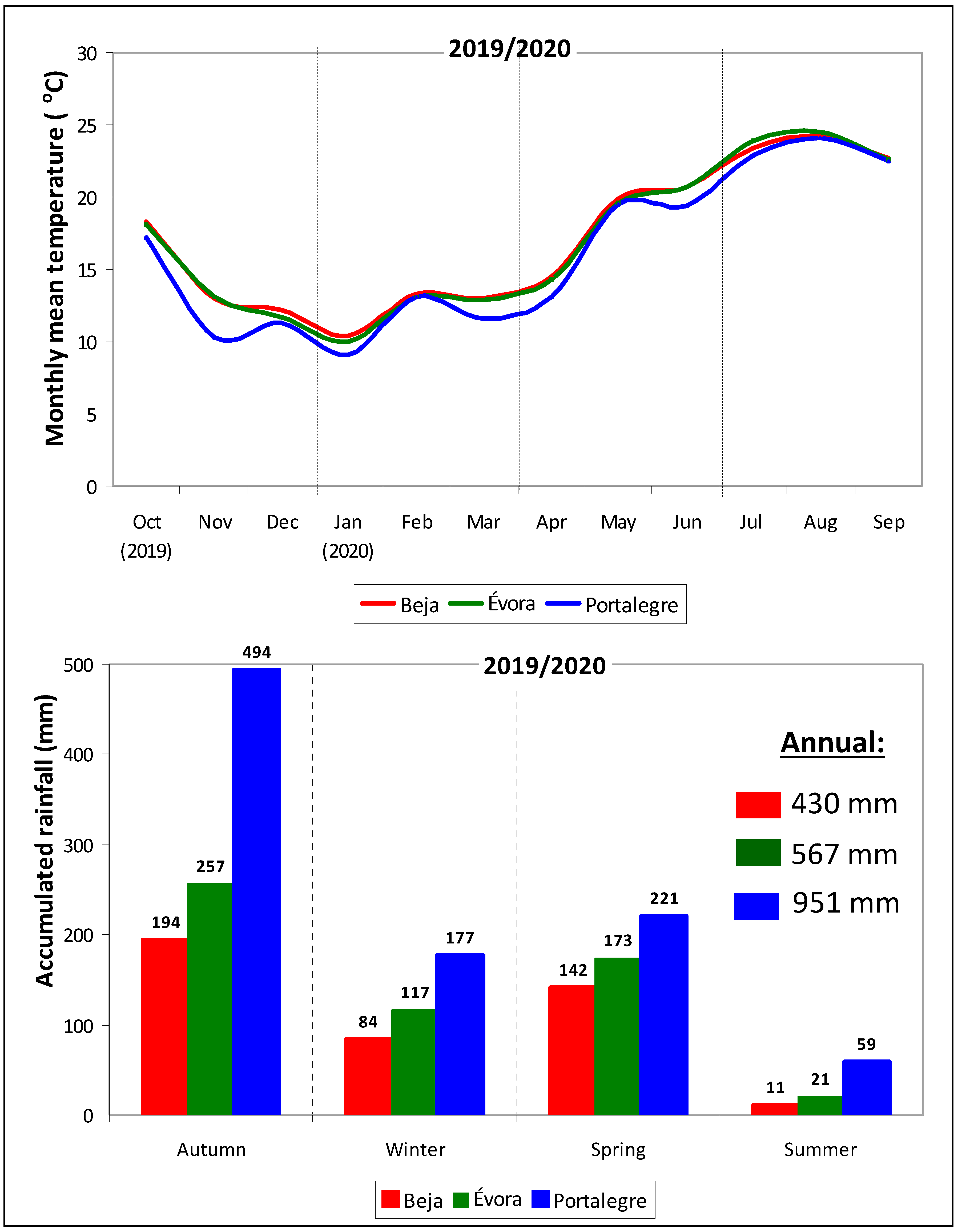
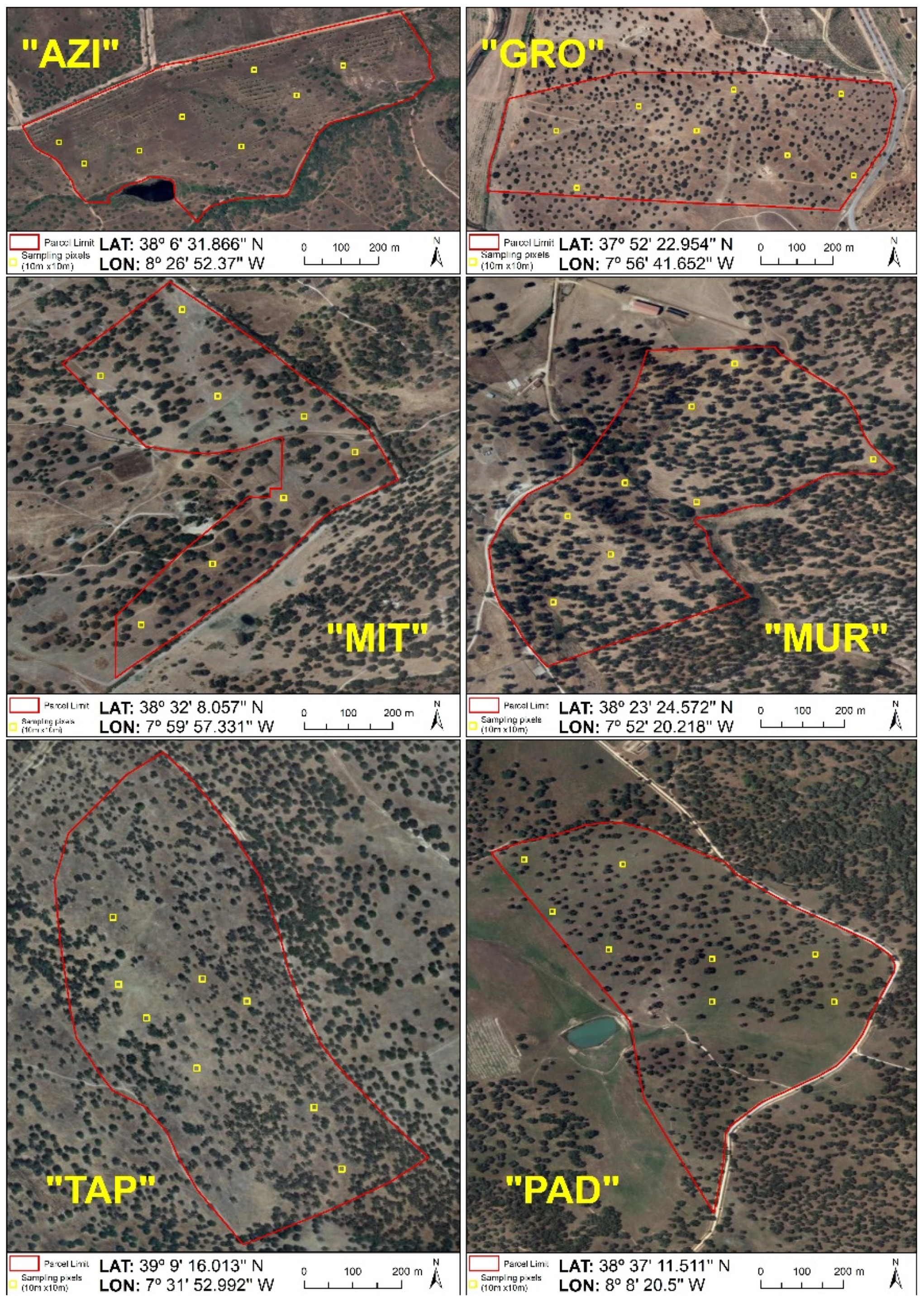
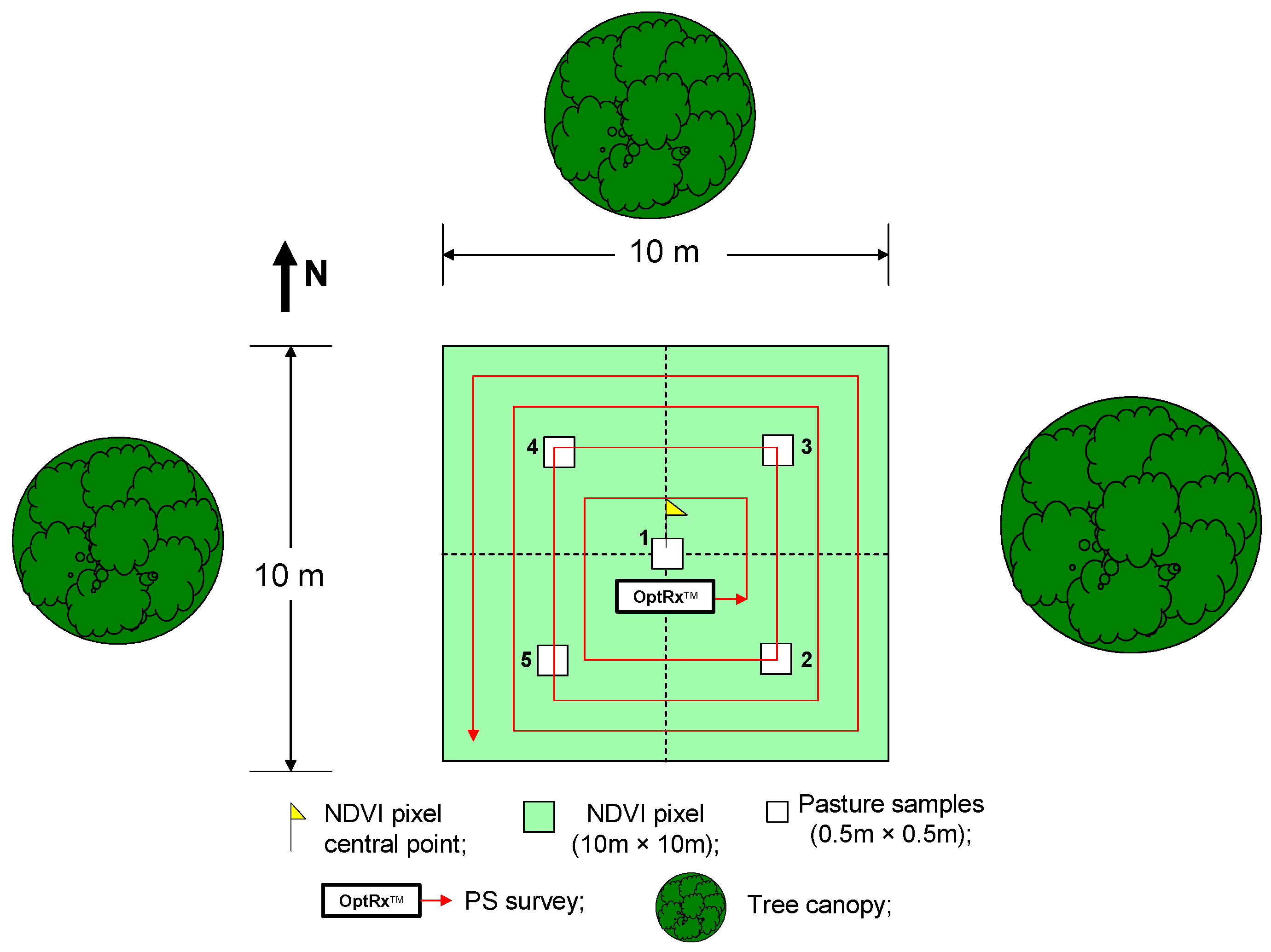


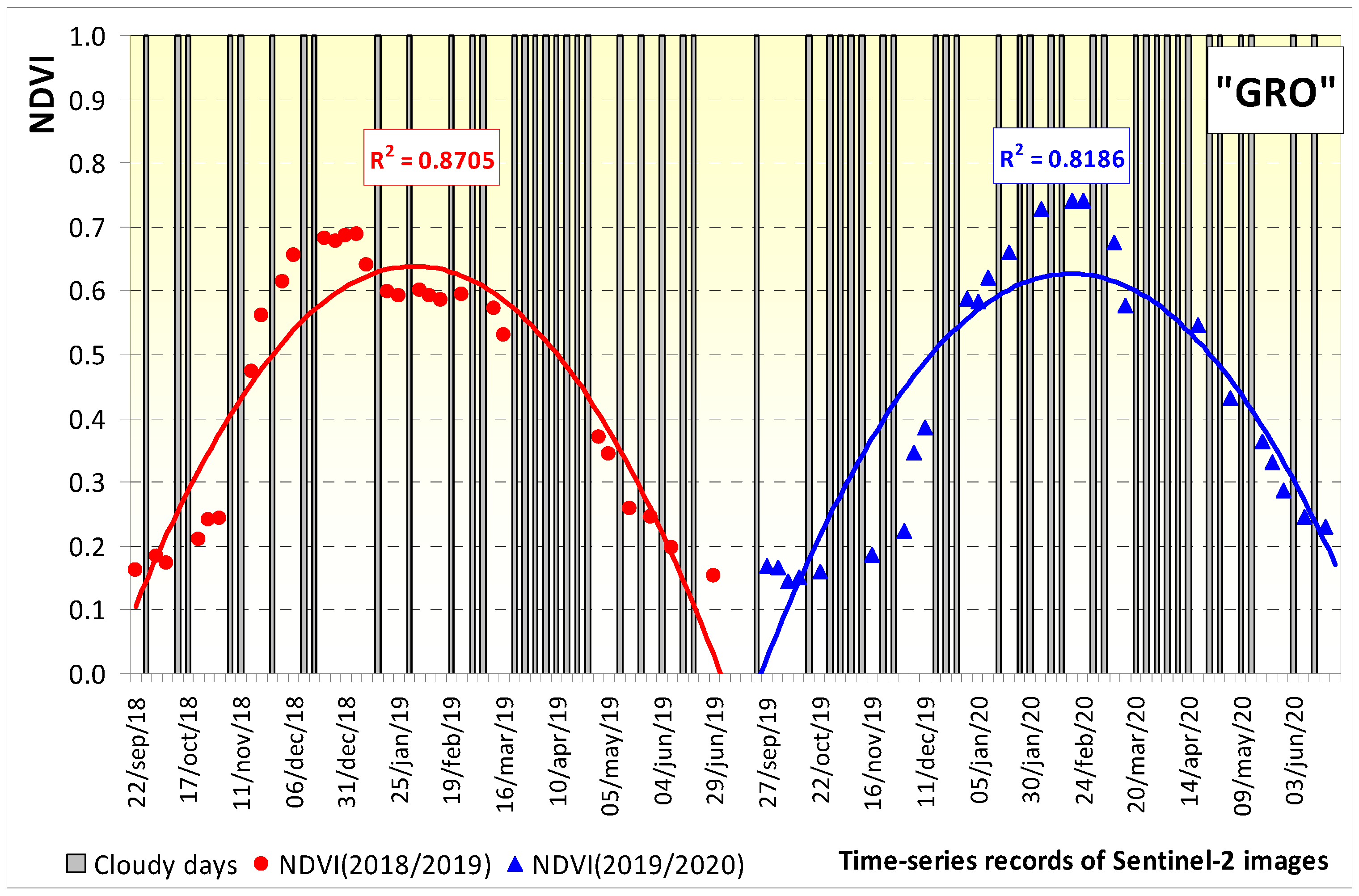
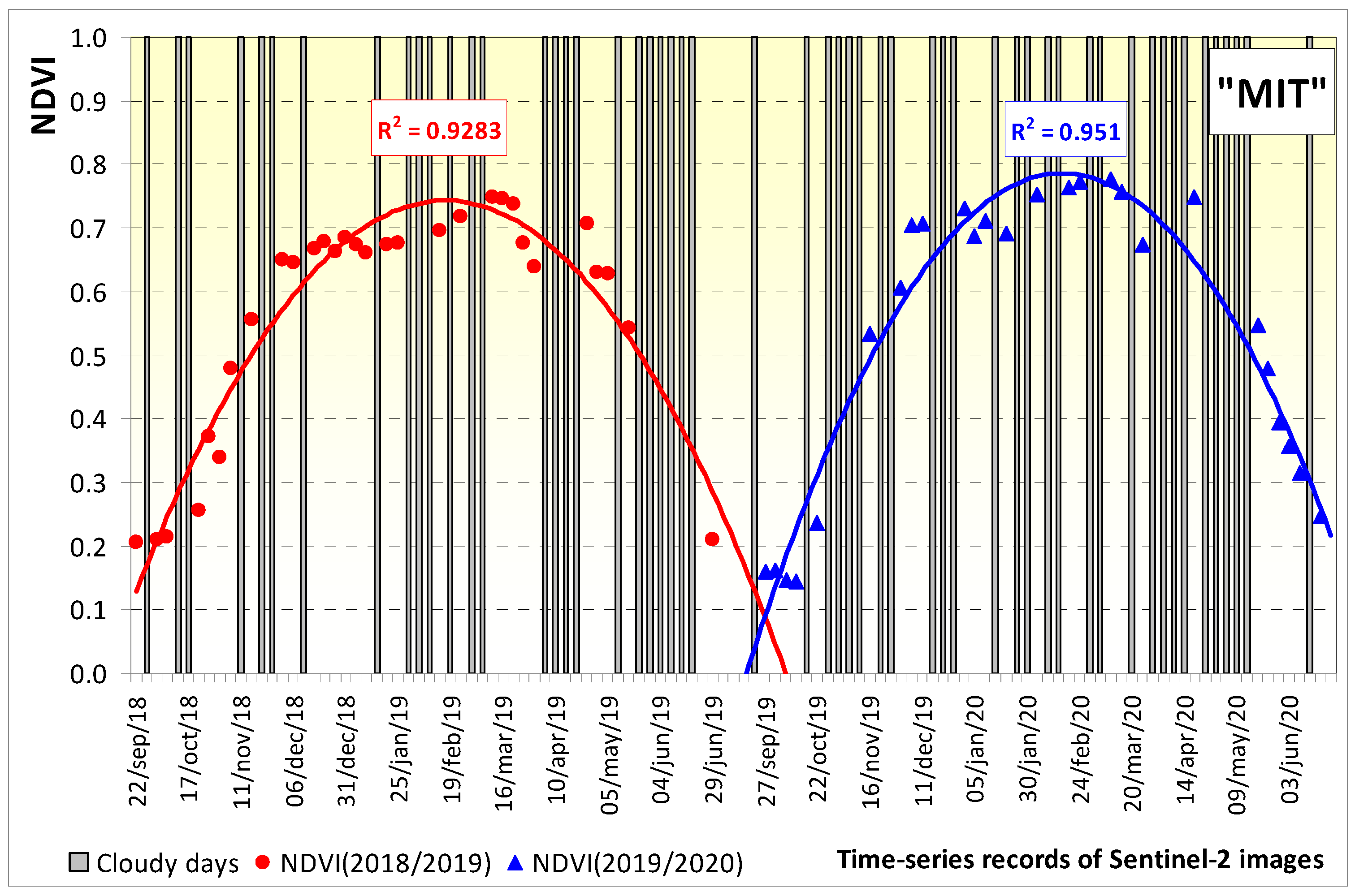
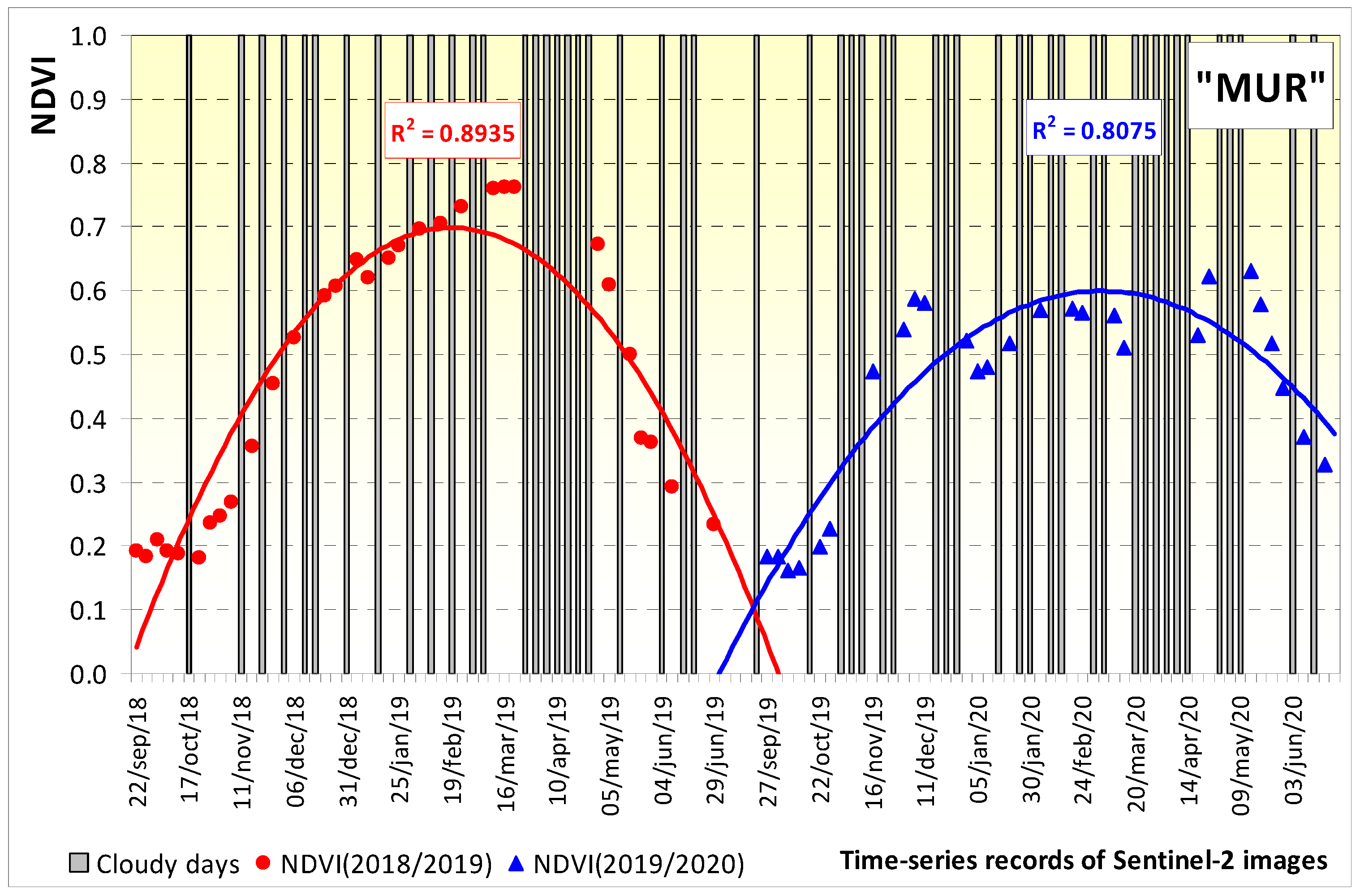

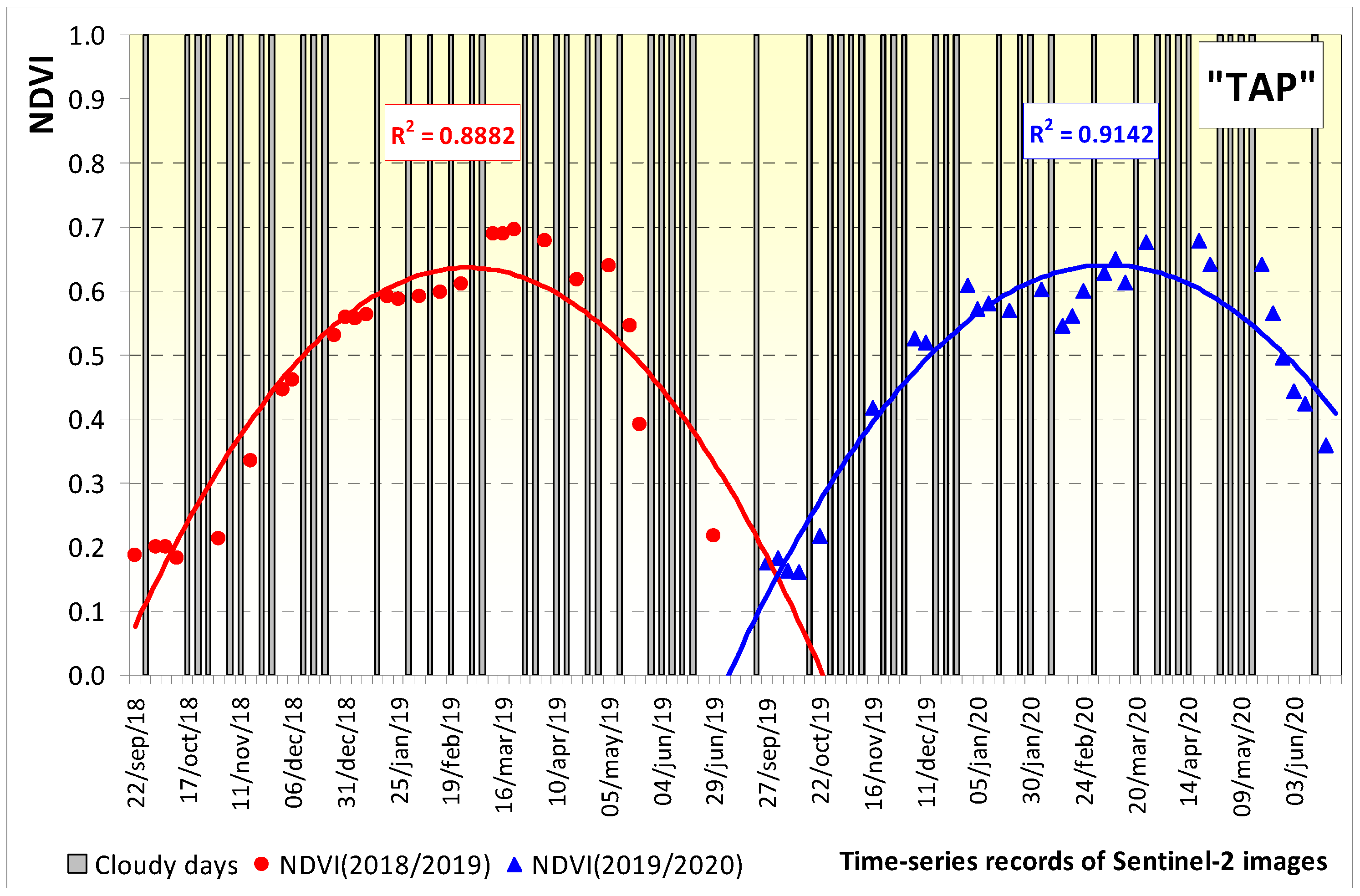

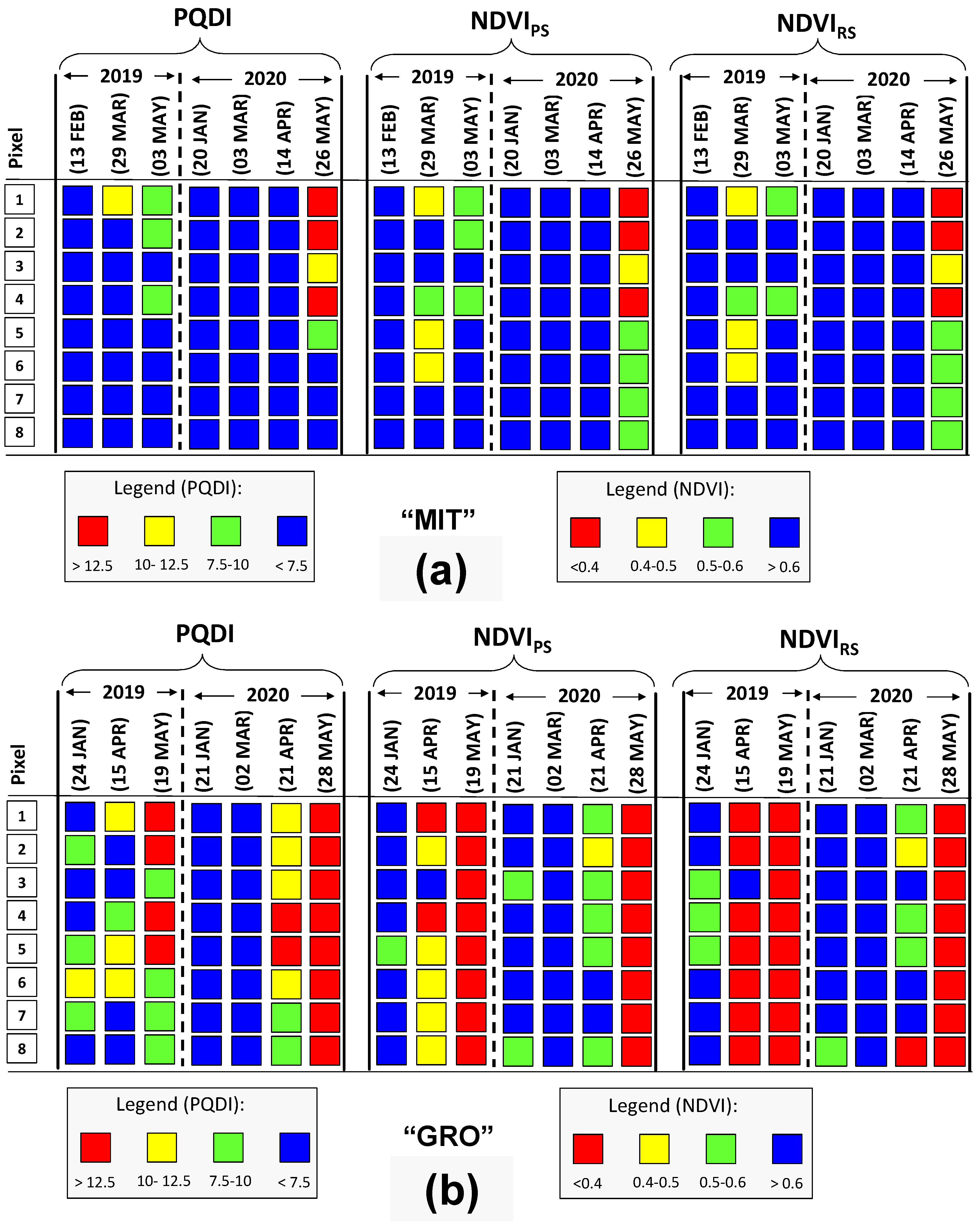
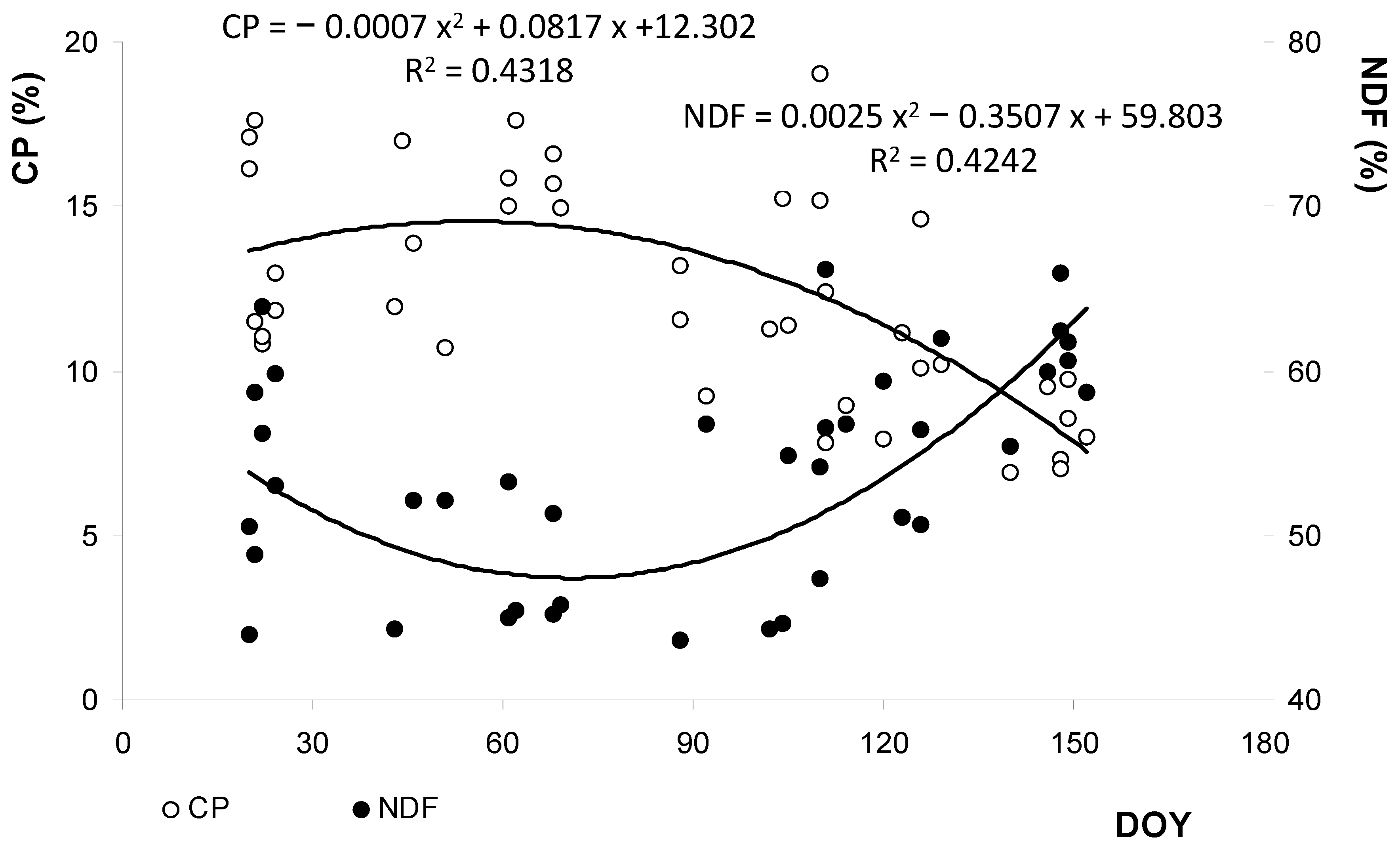
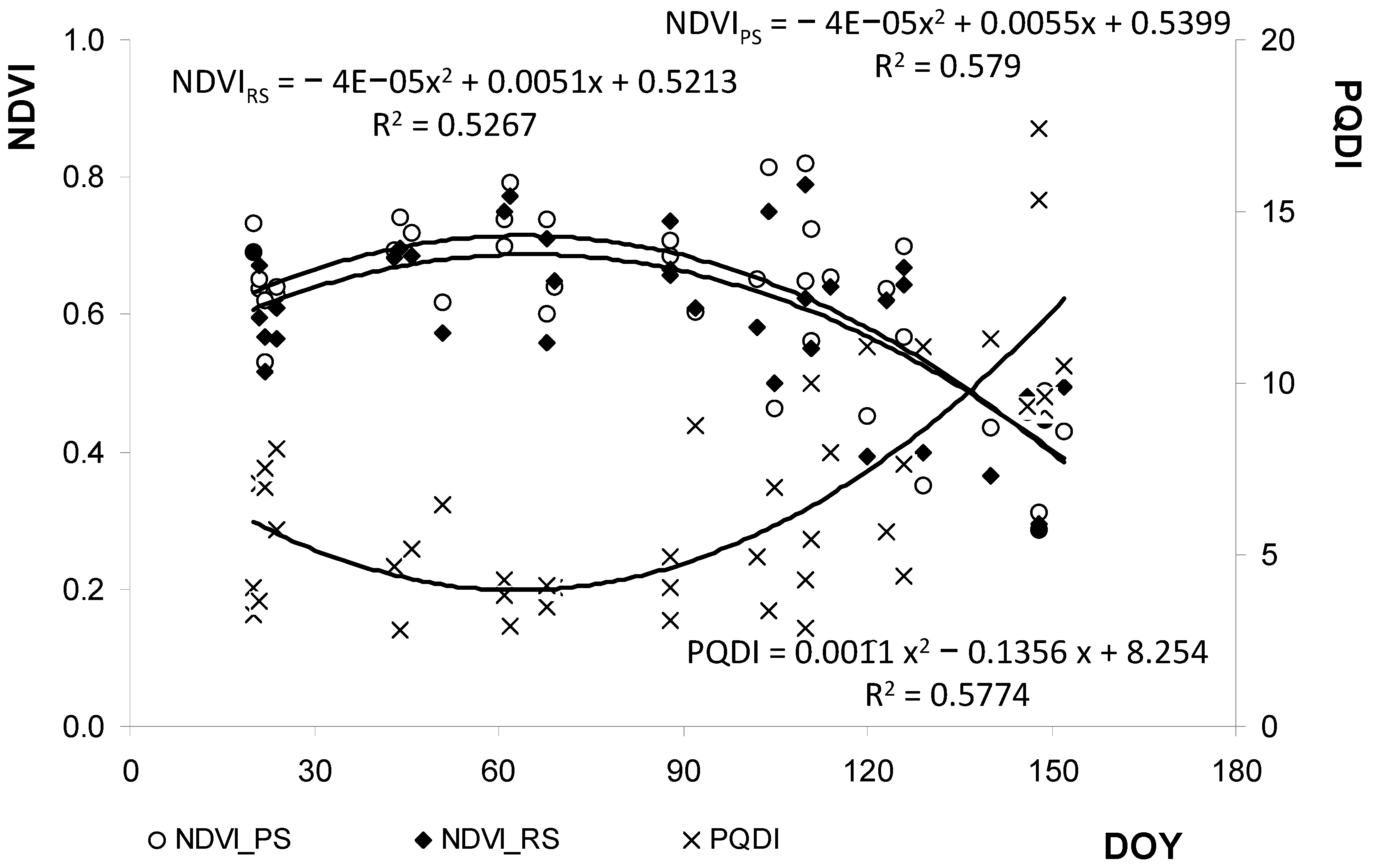
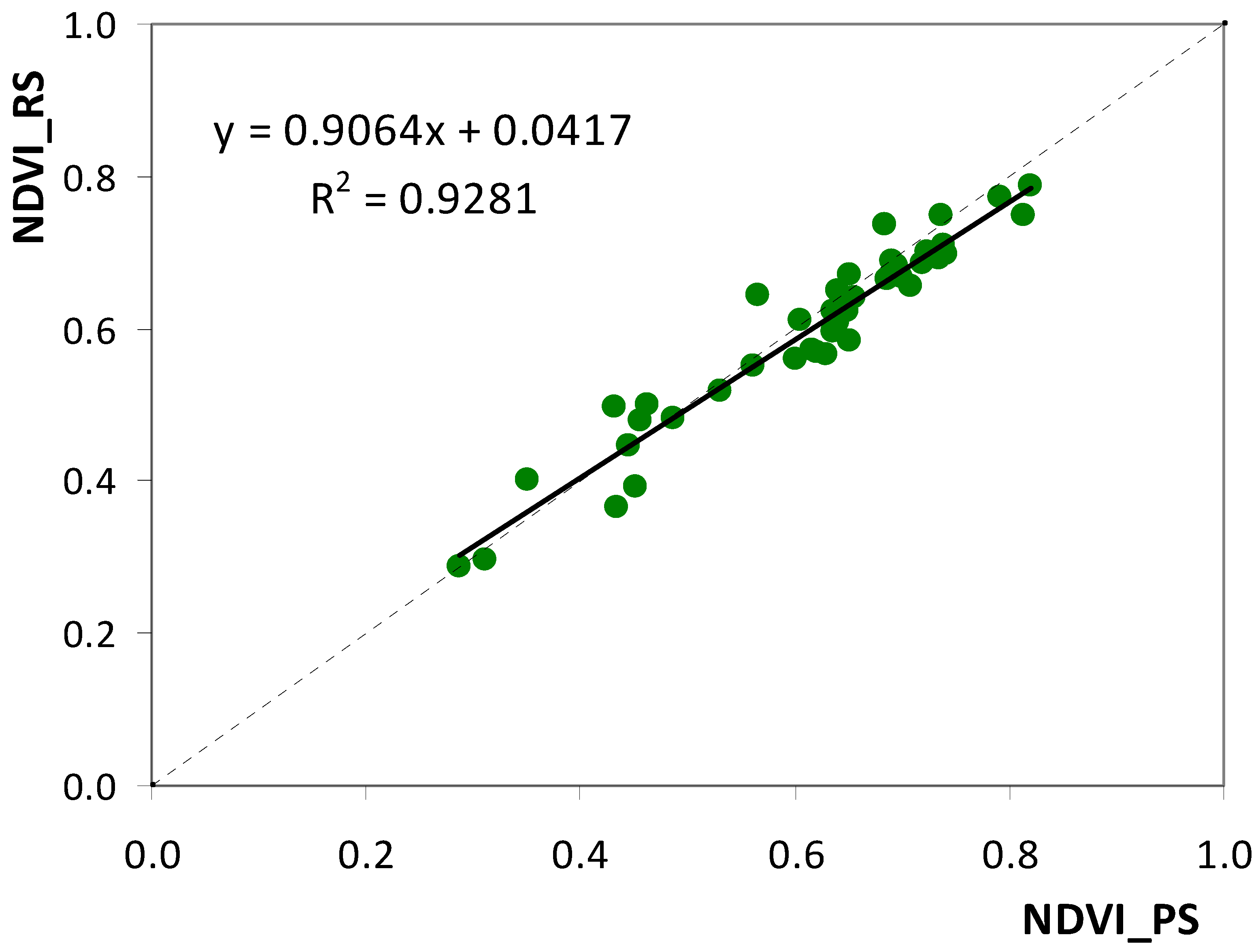
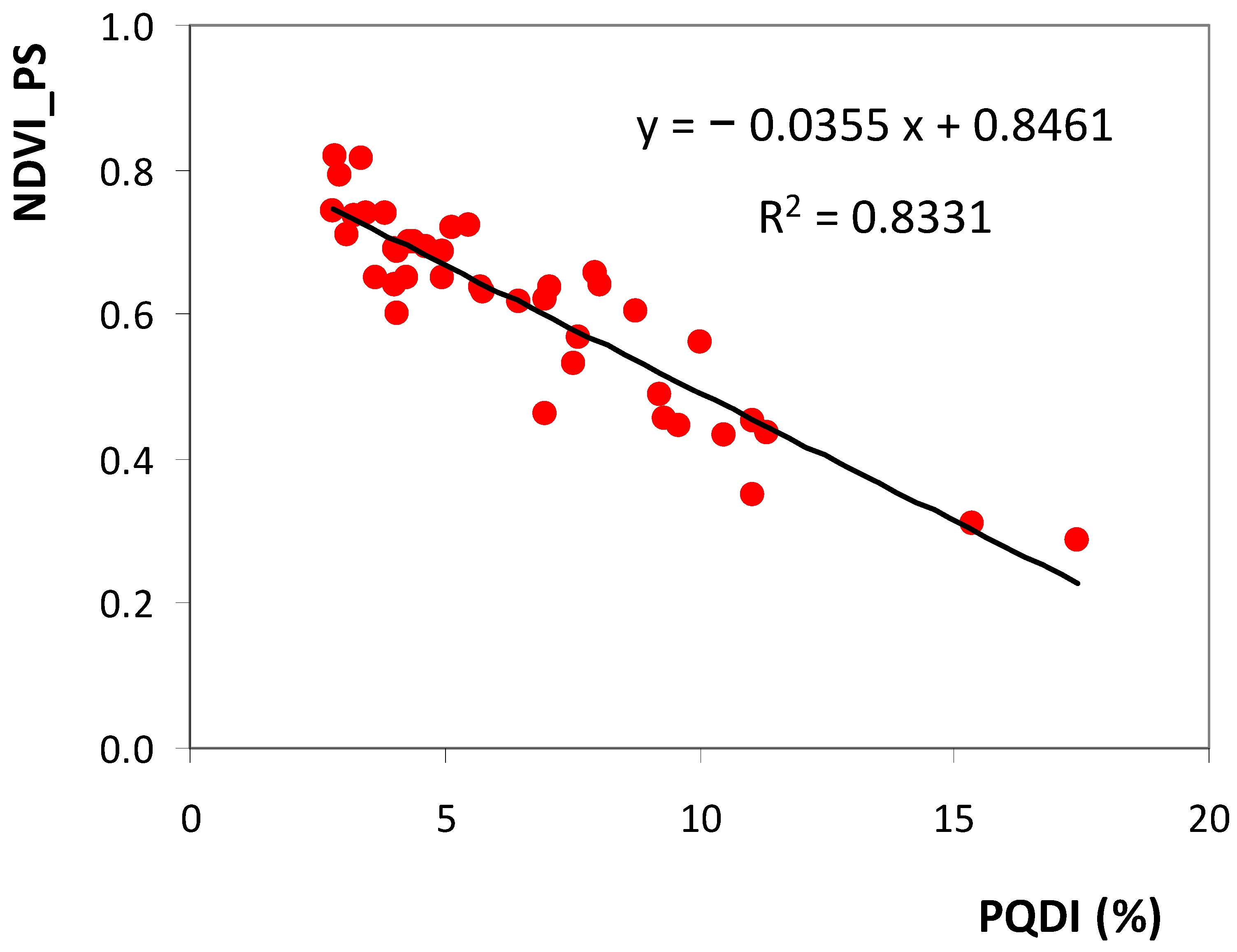
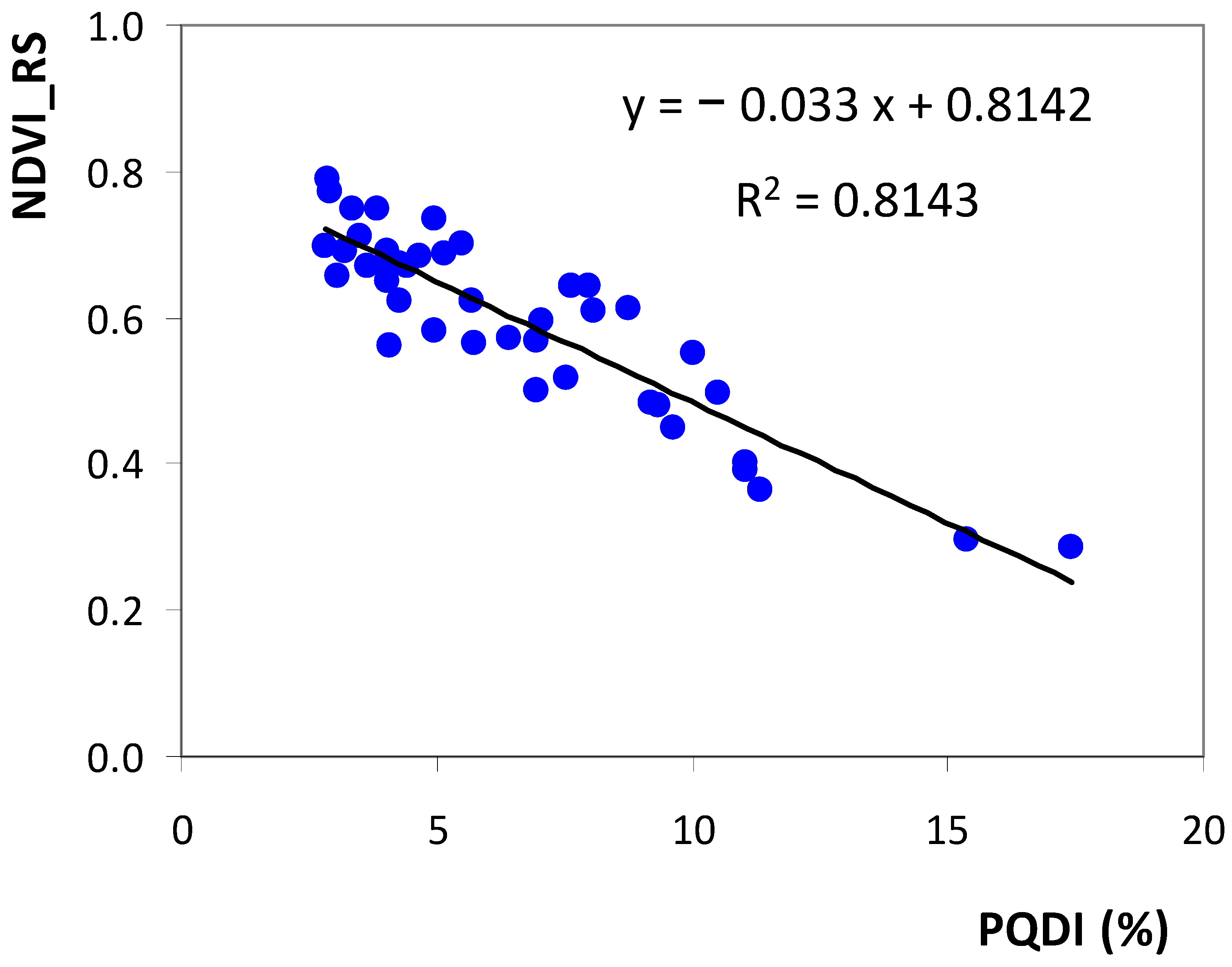
| Field Code | Year | Autumn (21 Sep–20 Dec) | Winter (21 Dec–20 Mar) | Spring (21 Mar–20 Jun) | Vegetative Cycle (21 Sep–20 Jun) |
|---|---|---|---|---|---|
| AZI | 2018/2019 | 11/18 | 12/18 | 8/18 | 31/54 (57%) |
| 2019/2020 | 7/18 | 9/19 | 9/18 | 25/55 (45%) | |
| GRO | 2018/2019 | 10/18 | 13/18 | 5/18 | 28/54 (52%) |
| 2019/2020 | 9/18 | 9/19 | 7/18 | 25/55 (45%) | |
| MIT | 2018/2019 | 11/18 | 11/18 | 7/18 | 29/54 (54%) |
| 2019/2020 | 9/18 | 9/19 | 8/18 | 26/55 (47%) | |
| MUR | 2018/2019 | 12/18 | 11/18 | 7/18 | 30/54 (56%) |
| 2019/2020 | 10/18 | 9/19 | 8/18 | 27/55 (49%) | |
| PAD | 2018/2019 | 10/18 | 12/18 | 13/18 | 35/54 (65%) |
| 2019/2020 | 6/18 | 9/19 | 9/18 | 24/55 (44%) | |
| TAP | 2018/2019 | 8/18 | 11/18 | 6/18 | 25/54 (46%) |
| 2019/2020 | 8/18 | 11/19 | 9/18 | 28/55 (51%) |
| Field Code | Sampling Date | DOY (2019) | PMC | CP | NDF | NDVIPS | Date of RS Capture * | DOY (2019) | Gap PS-RS (Days) | NDVIRS |
|---|---|---|---|---|---|---|---|---|---|---|
| 24/Jan | 24 | 71.0 ± 7.0 | 13.0 ± 2.5 | 53.0 ± 6.0 | 0.629 ± 0.035 | 25/Jan | 25 | 1 | 0.566 ± 0.029 | |
| AZI | 02/Apr | 92 | 70.2 ± 4.8 | 9.2 ± 1.0 | 56.8 ± 4.3 | 0.605 ± 0.055 | 16/Mar | 75 | −17 | 0.611 ± 0.038 |
| 30/Apr | 120 | 67.5 ± 5.5 | 7.9 ± 1.1 | 59.3 ± 5.6 | 0.451 ± 0.047 | 05/May | 125 | 5 | 0.392 ± 0.038 | |
| 24/Jan | 24 | 62.5 ± 6.2 | 11.9 ± 1.1 | 59.9 ± 3.0 | 0.641 ± 0.057 | 25/Jan | 25 | 1 | 0.609 ± 0.041 | |
| GRO | 15/Apr | 105 | 69.2 ± 8.7 | 11.4 ± 2.6 | 54.9 ± 6.1 | 0.463 ± 0.064 | 05/May | 125 | 20 | 0.450 ± 0.033 |
| 09/May | 129 | 54.9 ± 9.6 | 10.2 ± 2.3 | 62.0 ± 6.4 | 0.351 ± 0.030 | 15/May | 135 | 6 | 0.342 ± 0.018 | |
| 13/Feb | 44 | 82.4 ± 2.6 | 17.0 ± 3.8 | 39.6 ± 5.6 | 0.742 ± 0.049 | 14/Feb | 45 | 1 | 0.697 ± 0.032 | |
| MIT | 29/Mar | 88 | 78.5 ± 8.5 | 15.9 ± 4.1 | 38.4 ± 7.5 | 0.709 ± 0.089 | 31/Mar | 90 | 2 | 0.656 ± 0.062 |
| 03/May | 123 | 80.5 ± 2.3 | 11.1 ± 1.6 | 51.1 ± 4.7 | 0.637 ± 0.089 | 05/May | 125 | 2 | 0.622 ± 0.039 | |
| 12/Feb | 43 | 79.7 ± 3.1 | 11.9 ± 2.3 | 44.3 ± 4.3 | 0.695 ± 0.081 | 04/Feb | 35 | −8 | 0.683 ± 0.058 | |
| MUR | 29/Mar | 88 | 76.3 ± 5.3 | 11.6 ± 2.5 | 43.7 ± 6.1 | 0.685 ± 0.057 | 21/Mar | 80 | −8 | 0.735 ± 0.036 |
| 06/May | 126 | 73.3 ± 6.6 | 10.1 ± 2.4 | 56.4 ± 5.2 | 0.566 ± 0.075 | 30/Apr | 120 | −6 | 0.643 ± 0.051 | |
| 15/Feb | 46 | 72.8 ± 4.6 | 13.9 ± 5.5 | 52.1 ± 8.8 | 0.719 ± 0.015 | 24/Feb | 55 | 9 | 0.685 ± 0.023 | |
| PAD | 29/Mar | 88 | 73.7 ± 3.4 | 13.2 ± 2.5 | 39.4 ± 4.3 | 0.686 ± 0.034 | 26/Mar | 85 | −3 | 0.666 ± 0.028 |
| 06/May | 126 | 78.5 ± 3.2 | 14.6 ± 2.6 | 50.6 ± 4.0 | 0.700 ± 0.057 | 05/May | 125 | −1 | 0.668 ± 0.040 | |
| 20/Feb | 51 | 75.7 ± 4.9 | 10.7 ± 2.0 | 52.2 ± 5.1 | 0.617 ± 0.041 | 14/Feb | 45 | −6 | 0.572 ± 0.044 | |
| TAP | 12/Apr | 102 | 79.2 ± 4.1 | 11.3 ± 3.9 | 44.3 ± 7.6 | 0.652 ± 0.093 | 20/Apr | 110 | 8 | 0.582 ± 0.069 |
| 20/May | 140 | 70.9 ± 3.6 | 6.9 ± 0.9 | 55.4 ± 5.4 | 0.435 ± 0.075 | 25/May | 145 | 5 | 0.365 ± 0.056 |
| Field Code | Sampling Date | DOY (2020) | PMC | CP | NDF | NDVIPS | Date of RS Capture * | DOY (2020) | Gap PS-RS (Days) | NDVIRS |
|---|---|---|---|---|---|---|---|---|---|---|
| 21/Jan | 21 | 72.1 ± 4.7 | 11.5 ± 1.8 | 58.7 ± 5.3 | 0.636 ± 0.055 | 20/Jan | 20 | −1 | 0.596 ± 0.063 | |
| AZI | 02/Mar | 61 | 78.2 ± 3.7 | 15.8 ± 1.1 | 53.2 ± 3.7 | 0.698 ± 0.045 | 10/Mar | 69 | 8 | 0.674 ± 0.065 |
| 21/Apr | 111 | 83.1 ± 1.9 | 12.4 ± 1.8 | 56.5 ± 3.5 | 0.724 ± 0.035 | 19/Apr | 109 | −2 | 0.702 ± 0.072 | |
| 28/May | 148 | 55.7 ± 6.9 | 7.3 ± 1.9 | 62.5 ± 2.3 | 0.310 ± 0.026 | 29/May | 149 | 1 | 0.296 ± 0.022 | |
| 21/Jan | 21 | 75.9 ± 4.6 | 17.6 ± 2.3 | 48.9 ± 4.2 | 0.651 ± 0.072 | 20/Jan | 20 | 1 | 0.671 ± 0.065 | |
| GRO | 02/Mar | 61 | 78.2 ± 3.7 | 15.0 ± 0.6 | 45.0 ± 3.3 | 0.738 ± 0.042 | 10/Mar | 69 | 8 | 0.749 ± 0.053 |
| 21/Apr | 111 | 72.2 ± 2.9 | 7.8 ± 0.9 | 66.2 ± 3.6 | 0.561 ± 0.051 | 19/Apr | 109 | −2 | 0.551 ± 0.096 | |
| 28/May | 148 | 53.7 ± 6.9 | 7.0 ± 1.2 | 65.9 ± 3.1 | 0.288 ± 0.019 | 29/May | 149 | 1 | 0.287 ± 0.030 | |
| 20/Jan | 20 | 79.5 ± 5.8 | 17.1 ± 3.1 | 43.9 ± 9.1 | 0.734 ± 0.092 | 20/Jan | 20 | 0 | 0.691 ± 0.094 | |
| MIT | 03/Mar | 62 | 87.6 ± 1.8 | 17.6 ± 2.4 | 45.4 ± 3.3 | 0.793 ± 0.020 | 10/Mar | 69 | 7 | 0.772 ± 0.018 |
| 14/Apr | 104 | 87.1 ± 2.2 | 15.2 ± 3.5 | 44.7 ± 6.3 | 0.814 ± 0.046 | 19/Apr | 109 | 5 | 0.749 ± 0.078 | |
| 26/May | 146 | 67.4 ± 7.4 | 9.5 ± 2.1 | 59.9 ± 5.7 | 0.457 ± 0.086 | 24/May | 144 | −2 | 0.480 ± 0.129 | |
| 22/Jan | 22 | 76.8 ± 3.4 | 11.0 ± 3.1 | 63.9 ± 3.2 | 0.530 ± 0.062 | 20/Jan | 20 | −2 | 0.517 ± 0.040 | |
| MUR | 09/Mar | 68 | 79.9 ± 2.8 | 15.7 ± 5.8 | 51.3 ± 3.8 | 0.600 ± 0.046 | 10/Mar | 69 | 1 | 0.560 ± 0.034 |
| 20/Apr | 110 | 83.2 ± 1.4 | 15.2 ± 3.1 | 54.2 ± 3.7 | 0.649 ± 0.049 | 24/Apr | 114 | 4 | 0.622 ± 0.043 | |
| 29/May | 149 | 75.1 ± 4.3 | 8.6 ± 1.2 | 61.8 ± 3.3 | 0.446 ± 0.057 | 29/May | 149 | 0 | 0.447 ± 0.058 | |
| 20/Jan | 20 | 77.7 ± 3.7 | 16.1 ± 2.0 | 50.6 ± 3.7 | 0.690 ± 0.028 | 20/Jan | 20 | 0 | 0.690 ± 0.027 | |
| PAD | 09/Mar | 68 | 78.1 ± 2.0 | 16.6 ± 2.2 | 45.2 ± 2.5 | 0.739 ± 0.020 | 10/Mar | 69 | 1 | 0.711 ± 0.023 |
| 20/Apr | 110 | 86.8 ± 1.5 | 19.0 ± 2.6 | 47.4 ± 1.9 | 0.820 ± 0.029 | 19/Apr | 109 | −1 | 0.788 ± 0.031 | |
| 29/May | 149 | 67.6 ± 3.1 | 9.7 ± 1.1 | 60.6 ± 2.0 | 0.488 ± 0.042 | 29/May | 149 | 0 | 0.481 ± 0.035 | |
| 22/Jan | 22 | 74.5 ± 7.5 | 10.8 ± 4.3 | 56.2 ± 9.4 | 0.620 ± 0.058 | 20/Jan | 20 | −2 | 0.569 ± 0.085 | |
| TAP | 10/Mar | 69 | 76.1 ± 4.6 | 15.0 ± 3.3 | 45.8 ± 4.0 | 0.640 ± 0.053 | 10/Mar | 69 | 0 | 0.649 ± 0.042 |
| 24/Apr | 114 | 79.4 ± 2.2 | 9.0 ± 1.1 | 56.7 ± 5.5 | 0.656 ± 0.055 | 24/Apr | 114 | 0 | 0.641 ± 0.038 | |
| 01/Jun | 152 | 70.0 ± 6.5 | 8.0 ± 1.4 | 58.7 ± 7.0 | 0.431 ± 0.051 | 29/May | 149 | −3 | 0.496 ± 0.021 |
Publisher’s Note: MDPI stays neutral with regard to jurisdictional claims in published maps and institutional affiliations. |
© 2021 by the authors. Licensee MDPI, Basel, Switzerland. This article is an open access article distributed under the terms and conditions of the Creative Commons Attribution (CC BY) license (https://creativecommons.org/licenses/by/4.0/).
Share and Cite
Serrano, J.; Shahidian, S.; Paixão, L.; Marques da Silva, J.; Morais, T.; Teixeira, R.; Domingos, T. Spatiotemporal Patterns of Pasture Quality Based on NDVI Time-Series in Mediterranean Montado Ecosystem. Remote Sens. 2021, 13, 3820. https://doi.org/10.3390/rs13193820
Serrano J, Shahidian S, Paixão L, Marques da Silva J, Morais T, Teixeira R, Domingos T. Spatiotemporal Patterns of Pasture Quality Based on NDVI Time-Series in Mediterranean Montado Ecosystem. Remote Sensing. 2021; 13(19):3820. https://doi.org/10.3390/rs13193820
Chicago/Turabian StyleSerrano, João, Shakib Shahidian, Luis Paixão, José Marques da Silva, Tiago Morais, Ricardo Teixeira, and Tiago Domingos. 2021. "Spatiotemporal Patterns of Pasture Quality Based on NDVI Time-Series in Mediterranean Montado Ecosystem" Remote Sensing 13, no. 19: 3820. https://doi.org/10.3390/rs13193820
APA StyleSerrano, J., Shahidian, S., Paixão, L., Marques da Silva, J., Morais, T., Teixeira, R., & Domingos, T. (2021). Spatiotemporal Patterns of Pasture Quality Based on NDVI Time-Series in Mediterranean Montado Ecosystem. Remote Sensing, 13(19), 3820. https://doi.org/10.3390/rs13193820








